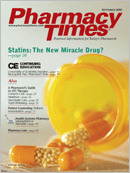Publication
Article
Pharmacy Times
Tooth Whitening Products
Author(s):
Tooth whitening has become very trendy over the past 5 to 10 years. Patients are always searching for the best ways to "brighten" their smiles. Due to the increasing demand for whiter teeth, a variety of whitening methods have become available for patients to use.
What Can Cause Stains or Discolorations on Teeth?
Teeth can become stained or discolored in various ways. The easiest stains to remove are called "extrinsic stains."1 These are superficial stains caused by smoking; drinking coffee, tea, or red wine; or eating staining foods. Extrinsic stains tend to respond very well to bleaching. "Intrinsic stains" are considered to be more challenging because they affect the deeper layers of the tooth. Stains from taking certain medicines, such as tetracyclines, are a good example. Too much fluoride also may cause intrinsic stains.1 Bleaching intrinsic stains usually works to some degree, but it may take a long time to remove them.1
A third type of stain is "age-related." It is a combination of both intrinsic and extrinsic factors. As people age, the dentin (the inner portion of the tooth) gets slightly yellow and may be visible through the translucent outer enamel. Yellow stains are the easiest to remove with bleaching. Gray or black stains tend to be more difficult.1
What Is Whitening?
According to the American Dental Association, "whitening" is any process that will make teeth appear whiter. The goal can be achieved in 2 ways. A product can bleach the tooth, actually changing its natural tooth color. Bleaching products contain peroxide( s) that help remove deep (intrinsic) and surface (extrinsic) stains. By contrast, nonbleaching whitening products contain agents that work by physical or chemical action to help remove surface stains only.2
Currently, 3 methods are used to whiten teeth3:
- In-office dental bleaching
- Dental office-supported home bleaching
- OTC home bleaching (whitening) products (Table)
All of these methods utilize carbamide peroxide or hydrogen peroxide in a variety of strengths. Professional whitening is mostly recommended for serious stains.
The different types of OTC formulations available include the following:
- Whitening strips
- One-size-fits-all tray systems
- Brush-on whitening systems
- Whitening toothpastes
Patients should be advised to seek the advice of a dentist to ensure that they select the best method of tooth whitening for their individual needs. They also should be advised that these products work more effectively if their teeth are clean prior to using the products. They should not use any of the products for longer than instructed, and they should consult their dentist if they experience any adverse effects such as tooth sensitivity or irritation. Children and pregnant women should not use these products.
For a list of references, send a stamped, self-addressed envelope to: References Department, Attn. A. Stahl, Pharmacy Times, 241 Forsgate Drive, Jamesburg, NJ 08831; or send an e-mail request to: [email protected].







